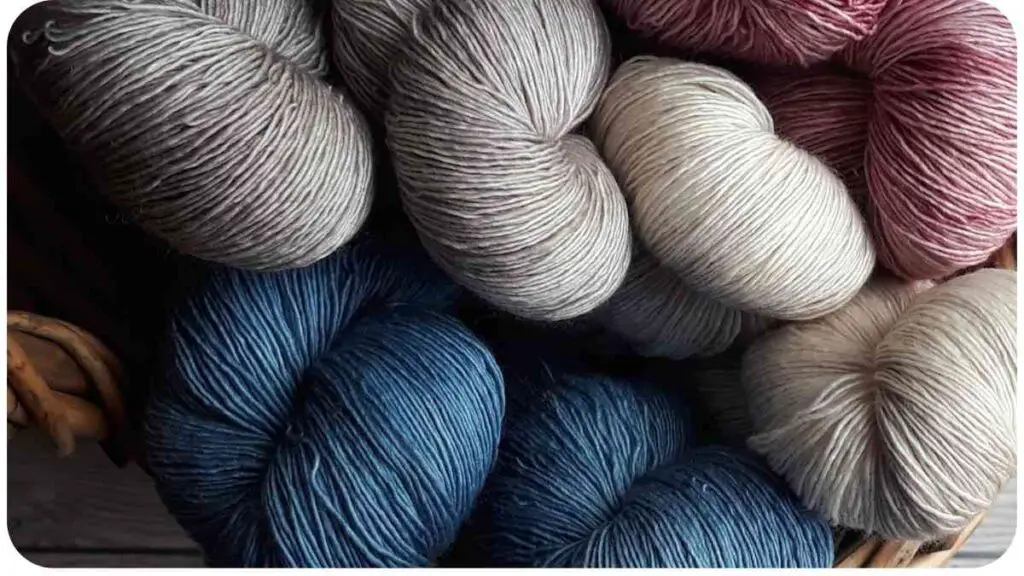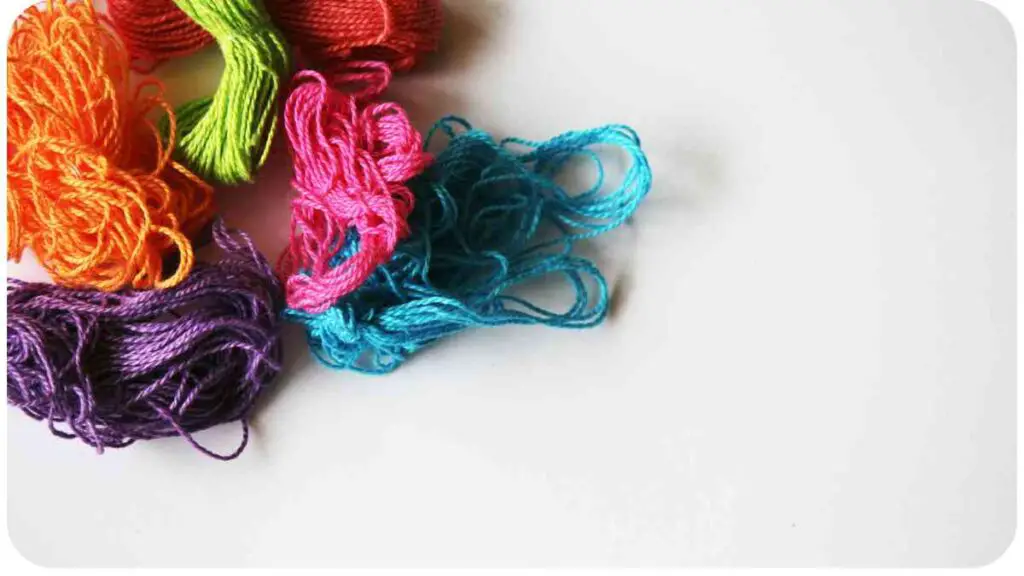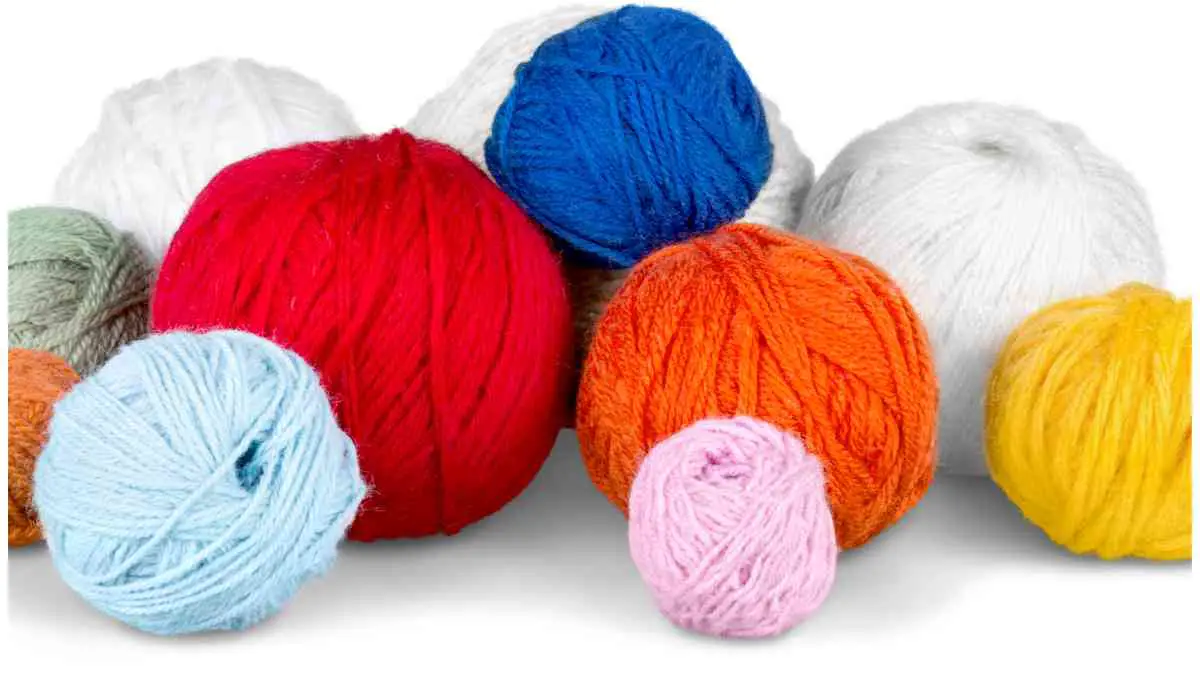Welcome to our comprehensive guide on how to soften your wool yarn! Working with wool yarn can be a delightful experience, but sometimes the yarn can feel scratchy and unpleasant against your skin.
In this article, we will share expert insights and personal experiences on how to soften wool yarn effectively. Whether you’re a seasoned knitter or just starting out, this step-by-step guide will help you achieve soft and cozy results. So let’s dive in and make your wool yarn softer than ever!
| Takeaways |
|---|
| 1. Softening yarn can enhance the comfort and quality of knitted or crocheted items. |
| 2. Different methods can be used to soften yarn, such as soaking in a softening solution, conditioning with hair conditioner, or using steam treatment. |
| 3. It’s important to follow instructions and guidelines provided by the method or product used to avoid damaging the yarn. |
| 4. Blocking and drying the softened yarn properly helps maintain its softness and shape. |
| 5. Blending wool yarn with other fibers or choosing acrylic blends can further enhance softness. |
| 6. Storing softened yarn in a clean and dry space can help preserve its softness and prevent damage. |
| 7. Avoid common mistakes like over-soaking, using harsh chemicals, and aggressive handling to ensure the best results. |
| 8. Consult further reading materials for additional guidance and tips on softening specific types of yarn. |
2. Understanding the Characteristics of Wool Yarn
Before we delve into the softening techniques, it’s essential to understand the unique characteristics of wool yarn. Wool is a natural fiber sourced from sheep, known for its warmth, durability, and ability to retain moisture.
However, some wool yarn can feel stiff and prickly due to the microscopic barbs present on the individual fibers. These barbs can irritate sensitive skin, making it necessary to soften the yarn before use.
Softening yarn is an art, and this guide unveils the secrets. From natural methods to innovative techniques, discover softening wonders for your projects.
3. Why Do You Need to Soften Wool Yarn?

Softening wool yarn not only enhances its comfort against the skin but also improves its drape and overall appearance in finished projects. By softening the yarn, you can make it more pliable and easier to work with, resulting in beautifully crafted garments and accessories.
Additionally, softened wool yarn is often more suitable for individuals with skin sensitivities, allowing them to enjoy the warmth and coziness of wool without any discomfort.
4. Preparing Your Wool Yarn
4.1 Choosing the Right Wool Yarn
When selecting wool yarn for your projects, consider the desired softness and the intended use of the finished item. Some wool fibers, such as Merino wool, are naturally softer and more suitable for sensitive skin.
Other breeds of sheep may produce coarser wool yarn, which can benefit from softening techniques. Understanding the wool fiber’s characteristics and selecting the appropriate yarn can make a significant difference in achieving the desired level of softness.
Dive into the world of warmth! Learn how the right yarn choice transforms your projects into soft, cozy masterpieces, ensuring comfort in every stitch.
4.2 Washing Wool Yarn
Before softening your wool yarn, it’s important to clean it properly. Washing the yarn removes dirt, oils, and any residual chemicals, creating a fresh and clean foundation for the softening process. Start by filling a basin with lukewarm water and adding a mild wool detergent. Gently agitate the yarn in the water, being careful not to agitate vigorously or rub the fibers together, as this can cause felting. Rinse the yarn thoroughly and squeeze out the excess water, ensuring not to wring or twist it.
Table 1: Steps for Washing Wool Yarn
| Step | Instructions |
| 1 | Fill a basin with lukewarm water |
| 2 | Add a mild wool detergent to the water |
| 3 | Gently agitate the yarn in the water |
| 4 | Rinse the yarn thoroughly |
| 5 | Squeeze out the excess water without wringing or twisting the yarn |
5. Softening Techniques for Wool Yarn

Next, let’s explore various techniques to soften your wool yarn effectively. Each method has its own advantages, so feel free to choose the one that suits you best.
5.1 Soaking in a Fabric Softener Solution
One popular method to soften wool yarn is by soaking it in a fabric softener solution. Fill a basin with lukewarm water and add a small amount of fabric softener. Place the yarn in the solution, ensuring it’s fully submerged. Let it soak for at least 20 minutes, or longer if desired.
After 20 minutes, remove the yarn from the solution and gently squeeze out the excess liquid. Avoid wringing the yarn or applying too much pressure, as this can damage the fibers. Rinse the yarn under running water to remove any remaining fabric softener.
Table 2: Softening Wool Yarn with Fabric Softener
| Step | Instructions |
| 1 | Fill a basin with lukewarm water |
| 2 | Add a small amount of fabric softener |
| 3 | Submerge the yarn in the solution and let it soak for at least 20 minutes |
| 4 | Gently squeeze out the excess liquid |
| 5 | Rinse the yarn under running water to remove any remaining fabric softener |
Using a fabric softener can help relax the fibers and make the yarn feel softer. However, be cautious not to use too much fabric softener, as it can leave a residue on the yarn. Additionally, be mindful of any allergies or sensitivities you may have to certain fabric softeners.
Wool yarn deserves TLC! Uncover essential care tips to maintain the beauty and softness of your projects, ensuring longevity and enduring comfort.
5.2 Conditioning with Hair Conditioner
Another effective method for softening wool yarn is by using hair conditioner. After washing your yarn, fill a basin with lukewarm water. Add a small amount of hair conditioner and mix it well. Submerge the yarn in the conditioner solution, ensuring it’s fully saturated.
Allow it to soak for about 15 minutes, or longer if desired. After the soaking period, gently squeeze out the excess conditioner and rinse the yarn thoroughly.
Table 3: Softening Wool Yarn with Hair Conditioner
| Step | Instructions |
| 1 | Fill a basin with lukewarm water |
| 2 | Add a small amount of hair conditioner |
| 3 | Submerge the yarn in the conditioner solution and let it soak for about 15 minutes |
| 4 | Gently squeeze out the excess conditioner |
| 5 | Rinse the yarn thoroughly |
Hair conditioner helps to moisturize and soften the wool fibers, making them more pleasant to the touch. It’s advisable to choose a conditioner that is free from heavy fragrances or additives that may leave residue on the yarn.
5.3 Steam Treatment
If you want to soften your wool yarn without soaking it, steam treatment can be an effective option. Fill a kettle or pot with water and bring it to a boil. Hold the yarn over the steam, ensuring it doesn’t touch the water directly. Move the yarn gently through the steam for a few minutes, allowing the heat and moisture to relax the fibers. After the steam treatment, let the yarn cool down and dry naturally.
Variety adds spice to crochet! Delve into the world of textures and colors with our guide on different types of wool yarn, elevating your crochet creations to new heights.
Table 4: Softening Wool Yarn with Steam Treatment
| Step | Instructions |
| 1 | Bring water to a boil in a kettle or pot |
| 2 | Hold the yarn over the steam without touching water |
| 3 | Move the yarn gently through the steam |
| 4 | Allow the yarn to cool down and dry naturally |
Steam treatment is especially useful for delicate or easily feltable yarns. The steam helps to loosen the fibers and makes the yarn more pliable.
5.4 Using a Commercial Softening Product
If you prefer a more straightforward approach, you can consider using a commercial softening product specifically designed for wool yarn. These products come in various forms, including sprays or wash-in solutions. Follow the instructions provided by the manufacturer to apply the softening product to your yarn. Ensure that the product is suitable for the type of wool yarn you are using.
Table 5: Using a Commercial Softening Product
| Step | Instructions |
| 1 | Follow the instructions provided by the manufacturer for the specific softening product |
| 2 | Apply the product to the yarn as directed |
| 3 | Rinse or leave the product on the yarn, depending on the instructions |
Commercial softening products are formulated to effectively soften and condition wool yarn. They can save you time and effort, offering a convenient solution for achieving softer yarn.
6. Blocking and Drying Your Softened Wool Yarn
After you have successfully softened your wool yarn, it’s essential to block and dry it properly. Blocking refers to the process of shaping your knitted or crocheted pieces to the desired measurements. Follow the pattern instructions for blocking guidelines.
To block your softened wool yarn, lay it flat on a clean towel or blocking mat in the desired shape and measurements. Use rust proof pins to secure the edges and maintain the shape. Allow the yarn to dry fully before removing the pins. Avoid exposing the yarn to direct sunlight, as it can cause fading or damage to the fibers.
Softened wool yarn opens doors to creativity! Explore our showcase of inspiring projects, showcasing the versatility and beauty that softened wool brings to your handmade creations.
Table 6: Blocking and Drying Wool Yarn
| Step | Instructions |
| 1 | Lay the softened wool yarn flat on a clean towel or blocking mat in the desired shape |
| 2 | Use rustproof pins to secure the edges and maintain the shape |
| 3 | Allow the yarn to dry fully before removing the pins |
| 4 | Avoid exposing the yarn to direct sunlight, as it can cause fading or damage to the fibers |
Blocking helps to enhance the finished appearance of your knitted or crocheted items and ensures the softness is maintained.
7. Tips and Tricks for Softening Wool Yarn
Here are a few additional tips and tricks to help you achieve the best results when softening your wool yarn:
7.1 Blending Wool Yarn with Other Fibers
If you find that your wool yarn is still too scratchy even after softening, consider blending it with other fibers. You can experiment by adding silk, cashmere, or bamboo fibers to create a softer and more luxurious yarn blend. By combining fibers, you can customize the yarn’s characteristics and achieve the desired level of softness.
7.2 Storing Softened Wool Yarn
Once you have successfully softened your wool yarn, it’s important to store it properly to maintain its softness. Store the yarn in a clean and dry space, away from direct sunlight and sources of moisture. You can use zip-lock bags, sealable containers, or dedicated yarn storage solutions to protect your yarn from dust, pests, and any potential damage.
8. Common Mistakes to Avoid
While softening your wool yarn, it’s crucial to be mindful of a few common mistakes that could potentially impact the quality and softness of the yarn. Avoid the following:
- Over-soaking the yarn: Excessive soaking can weaken the yarn and affect its structure. Follow the recommended soaking times and avoid leaving the yarn submerged for too long.
- Using harsh chemicals: Be cautious with the products you use to soften your yarn. Harsh chemicals can damage the fibers and hinder the softening process. Stick to gentle and wool-specific products.
- Aggressive handling: When squeezing or drying the yarn, avoid excessive wringing or twisting, as it can cause stretching, felting, or breakage.
- Ignoring yarn care instructions: Every yarn has specific care instructions provided by the manufacturer. Failing to follow these instructions may lead to unintended consequences, such as felting or loss of softness.
9. Troubleshooting
In case you encounter any issues during the softening process or have questions, consult the FAQ section for troubleshooting tips and answers to common queries.
10. Frequently Asked Questions (FAQs)
Q1: Can I use regular fabric softener on wool yarn?
A1: It’s not recommended to use regular fabric softener on wool yarn, as it can leave a residue and affect the natural properties of the wool. Opt for mild wool-specific softeners or alternative methods like hair conditioner.
Q2: How long should I soak the yarn in the softening solution?
A2: The soaking time can vary depending on the method you choose. Typically, 15-30 minutes is sufficient. However, it’s always a good idea to check the instructions provided by the softening product or method you are using.
Q3: Can I soften wool yarn after it has been knitted or crocheted into a project?
A3: Yes, you can soften wool yarn after it has been incorporated into a project. However, it may be more challenging to apply some softening methods due to the project’s size and shape.
Q4: Is it necessary to block the yarn after softening?
A4: Blocking is not mandatory but highly recommended to achieve the best results. Blocking helps to shape and set your finished item while preserving the softness and drape of the yarn.
11. Conclusion
Softening your wool yarn is a valuable step in ensuring comfort and quality in your knitting or crocheting projects. By incorporating a range of techniques, such as soaking in a fabric softener solution, conditioning with hair conditioner, steam treatment, or using commercial softening products, you can transform scratchy wool yarn into a softer, more luxurious material.
Remember to prewash and properly care for your wool yarn to maintain its softness long-term. By following our step-by-step guide and implementing the tips and tricks provided, you’ll be able to enjoy the cozy warmth and softness of your wool yarn creations. So go ahead, soften your yarn, and embark on a delightful knitting or crocheting journey!
Further Reading
Here are some additional resources that you may find helpful for further information on softening yarn:
- Crochet Class: How to Soften Yarn: This article from Interweave provides detailed instructions on various methods to soften yarn, including blocking, washing, and conditioning. It also offers tips on choosing the right yarn for your projects.
- How to Soften Wool: Tricksy Knitter shares insights on softening wool yarn and offers a step-by-step guide on different techniques. It covers topics such as pre-soaking, using additives, and the benefits of softening wool.
- How to Soften Acrylic Yarn: The Ultimate Guide: If you are working with acrylic yarn and want to make it softer, this guide from The Loopy Lamb is a valuable resource. It outlines various methods and considerations specifically for softening acrylic yarn.
FAQs
Here are some frequently asked questions about softening yarn:
Can I use regular fabric softener on wool yarn?
Using regular fabric softener on wool yarn is not recommended, as it can leave a residue and affect the natural properties of the wool. It’s best to opt for milder wool-specific softeners or alternative methods like using hair conditioner.
How long should I soak the yarn in the softening solution?
The soaking time can vary depending on the method you choose. Typically, 15-30 minutes is sufficient. However, always check the instructions provided by the softening product or method you are using.
Can I soften wool yarn after it has been knitted or crocheted into a project?
Yes, you can soften wool yarn after it has been incorporated into a project. However, it may be more challenging to apply some softening methods due to the project’s size and shape.
Is it necessary to block the yarn after softening?
Blocking is not mandatory, but it is highly recommended to achieve the best results. Blocking helps to shape and set your finished item while preserving the softness and drape of the yarn.
Can softening methods be used on acrylic yarn?
Softening methods are primarily suited for natural fibers like wool. Acrylic yarn has different properties and may not respond to softening techniques in the same way. If you want a softer acrylic yarn, look for acrylic blends or different brands known for a softer feel.

My name is Hellen James, and I’m a crochet and knitting expert. I’ve been crocheting since I was just a kid, but I started taking it seriously when I realized that it was a great way to de-stress and relax. Now that I have kids of my own, I love teaching them how to do it too!

